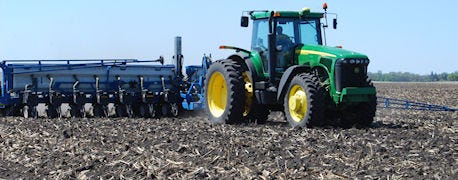April 19, 2015

This is a great time to be planting corn in Iowa. But watch the weather. "One thing to avoid is planting right before a drop in temperatures with a cold rain. You don't want the seed imbibing cold water," says Mark Johnson, Iowa State University Extension field agronomist in central Iowa. "The seed takes in 30% of its weight in water to start the germination process. You don't want that water to be in the 30-degree F range."

TOO COLD TO PLANT: Central Iowa soil temperatures last week were in the 50-degree range, ideal for planting corn. But soil temps at the 4-inch depth are forecast to drop back into the high 40s during the day and into the 30s at night early in the week of April 20.
Last week, soil temperatures were in the low-to-mid 50 degree range in central Iowa. But with the colder weather that was forecast as of Friday, April 17, soil temperatures at planting depth were expected to drop back into the high 40s beginning the week of April 20, as night temperatures were forecast to drop into the 30s and 40s.
Soil temperatures are posted by ISU Extension on the NPKnowledge website at extension.agron.iastate.edu/NPKnowledge/. "The bottom line here is that we know the current temperature and the forecast," says Johnson. "Pay attention to soil temperature and the weather forecast before you plant."
What is the best planting date for corn in central Iowa?
For central Iowa, ISU research indicates these two date ranges of interest to farmers and agronomists: planting corn between April 15 and May 18 (95% to 100% yield window) or between April 15 and May 9 (98% to 100% yield window). "So, if you don't have much corn planted by the time the rains begin, if it does indeed rain as forecast for the weekend of April 18-19, don't panic," says Johnson. "You still have time."
Cover crop termination, what is the best timing?
Johnson has had some calls from farmers asking about terminating cover crops. They want to know when is the best time to kill the cover crop? Johnson says rye cover crops should be killed soon if the field will be planted to corn; in general a height of 6 inches is probably best. Waiting until it gets taller can be problematic for a couple of reasons:
1) The more growth, the harder the rye is to kill, 2) the more growth, the more the residue could interfere with the following corn crop's yield. Additionally, because of the corn yield suppression concerns, it is usually recommended to not plant the field to corn for 10 days to two weeks after the rye has been terminated; the later the rye is terminated, the later the corn will be planted.
Mixing other herbicides with glyphosate for burndown?
He's also getting some calls about mixing other herbicides with glyphosate and using the mix as a burndown treatment. Some herbicides may reduce glyphosate efficacy when mixed with glyphosate, says Johnson. He suggests you read "Terminating Cover Crops" at extension.iastate.edu/CropNews/2014/0414hartzler.htm. The article was written by ISU Extension weed management specialist Bob Hartzler. In this article, Hartzler also notes that night temperatures of less than 40 degrees may reduce glyphosate activity.
You May Also Like




